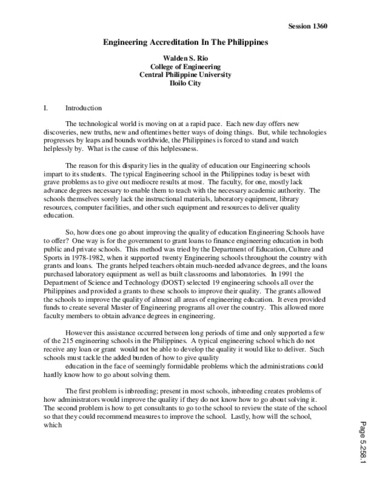Engineering accreditation In the Philippines
| dc.contributor.author | Rio, Walden S. | |
| dc.date.accessioned | 2021-12-15T04:16:30Z | |
| dc.date.available | 2021-12-15T04:16:30Z | |
| dc.date.issued | 2000-06-18 | |
| dc.identifier.citation | Rio, W. S. (2000). Engineering accreditation In the Philippines. In 2000 Annual Conference (pp. 5.258.1-5.258.8). St. Louis, Missouri: American Society for Engineering Education. | en_US |
| dc.identifier.issn | 2153-5965 | |
| dc.identifier.uri | https://hdl.handle.net/20.500.12852/1808 | |
| dc.description | Conference paper | en_US |
| dc.description.abstract | I. Introduction The technological world is moving on at a rapid pace. Each new day offers new discoveries, new truths, new and oftentimes better ways of doing things. But, while technologies progresses by leaps and bounds worldwide, the Philippines is forced to stand and watch helplessly by. What is the cause of this helplessness? The reason for this disparity lies in the quality of education our Engineering schools impart to its students. The typical Engineering school in the Philippines today is beset with grave problems as to give out mediocre results at most. The faculty, for one, mostly lack advance degrees necessary to enable them to teach with the necessary academic authority. The schools themselves sorely lack the instructional materials, laboratory equipment, library resources, computer facilities, and other such equipment and resources to deliver quality education. So, how does one go about improving the quality of education Engineering Schools have to offer? One way is for the government to grant loans to finance engineering education in both public and private schools. This method was tried by the Department of Education, Culture and Sports in 1978-1982, when it supported twenty Engineering schools throughout the country with grants and loans. The grants helped teachers obtain much-needed advance degrees, and the loans purchased laboratory equipment as well as built classrooms and laboratories. In 1991 the Department of Science and Technology (DOST) selected 19 engineering schools all over the Philippines and provided a grants to these schools to improve their quality. The grants allowed the schools to improve the quality of almost all areas of engineering education. It even provided funds to create several Master of Engineering programs all over the country. This allowed more faculty members to obtain advance degrees in engineering. However this assistance occurred between long periods of time and only supported a few of the 215 engineering schools in the Philippines. A typical engineering school which do not receive any loan or grant would not be able to develop the quality it would like to deliver. Such schools must tackle the added burden of how to give quality education in the face of seemingly formidable problems which the administrations could hardly know how to go about solving them. | en_US |
| dc.language.iso | en | en_US |
| dc.relation.uri | https://peer.asee.org/engineering-accreditation-in-the-philippines.pdf | en_US |
| dc.subject.lcsh | Engineering schools | en_US |
| dc.subject.lcsh | Engineering schools--Accreditation | en_US |
| dc.subject.lcsh | Accreditation (Education) | en_US |
| dc.subject.lcsh | Engineering--Study and teaching (Higher) | en_US |
| dc.subject.lcsh | Philippines | en_US |
| dc.title | Engineering accreditation In the Philippines | en_US |
| dc.type | Conference paper | en_US |
| dc.citation.firstpage | 5.258.1 | en_US |
| dc.citation.lastpage | 5.258.8 | en_US |
| dc.identifier.doi | 10.18260/1-2--8339 | |
| dc.citation.conferencetitle | 2000 Annual Conference | en_US |


